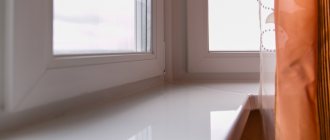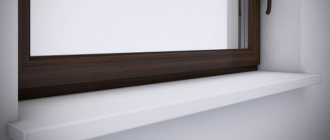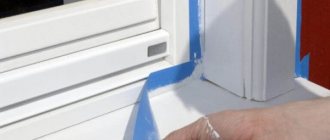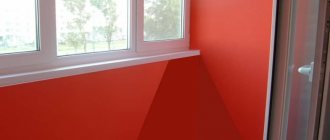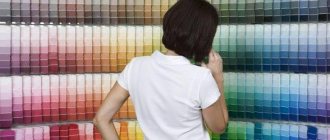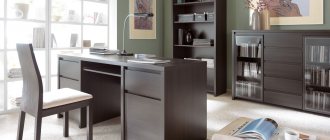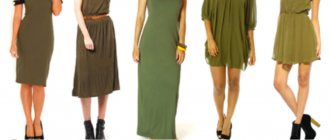Color perception affects the efficiency of our work. Colors that enhance efficiency in one office may do the opposite in another. Suitable shades may differ from one industry to another. You should also consider how the colors you use in your office affect your customers' opinion of your brand. The scale of your office, as well as the amount of natural light it receives, will also influence which color schemes work and which don't.
Obviously, a lot goes into getting an optimal result. We want to make this process easier by collecting information about the impact of color on behavior in the workplace and how choosing the right shade of paint can help you achieve your goals.
The influence of color on mood, productivity, comfort and energy levels
If you think color is just a style preference and has no real meaning, think again. The wrong decision will actually kill productivity. Conversely, wise interior color choices can have many positive effects, such as making employees feel focused and energized, which will impact their productivity.
Colors often depend on the industry, and for good reason.
In fact, the work that people are given in each department of the company is different, which is why you will see a different interior color scheme in each of them. Some shades help to calm a person, so they are used in rooms where work involves a high level of stress. There are also colors that influence an employee's creativity, which should be considered in positions where it is important to be innovative. Blue: Calmness and Productivity
Blue is the color most closely associated with stimulating the mind and creating an atmosphere conducive to more productive work activities. Blue tones are believed to affect us on a mental level, creating physical states of calm, tranquility and relaxation.
If your job requires constant focus and being stress-free, then choosing a shade of blue will be the best option.
Green: Balance, Calm and Growth
Green is a color known for its ability to create calm. It is also associated with balance and confidence. This is natural because in nature there is harmony between green leaves, grasses, bushes and shrubs and this is the reason why choosing green is “pleasant to the eye”.
Green tones are also a sign of growth, something the financial industry has taken notice of.
Luckily, there are many different shades of green that can be used in a variety of industries. Yellow: Creativity and Positivity
Ask an interior designer what two words they associate with yellow, and they will most likely answer “optimism and innovation.” Yellow not only lifts the mood and creates a feeling of happiness, but also stimulates creativity, which is why it is used as an accent color in offices where employees are tasked with thinking outside the box.
Yellow is the color of the sun and light, which can make people feel energetic.
However, be careful—too much yellow can be distracting and negatively impact your productivity. Orange: playfulness and creativity
Orange walls immediately make you think of citrus fruits, associating them with vitamin C and health. And although orange is a “hot” color, it is not an aggressive color. Some claim that it stimulates the brain by increasing the flow of oxygen to the frontal lobes.
Orange also has an element of change, perhaps because when the leaves change in the fall, many of them take on an orange hue, signifying the passing of summer, the beginning of autumn, and the approaching cold of winter.
Red: energy, attraction and aggression.
Red is intensity. It is difficult to use for general painting of a room, but it can become an important element in finishing. It is associated with everything from anger and energy to strength and determination. The color red is known to increase blood pressure, heart rate and metabolism.
Given that stop signs and fire trucks are red, it is not surprising that in places where red paint stands out, people are more motivated to react.
Purple: Quality and Luxury
Interestingly, purple contains a mixture of emotions associated with red and blue, so it is often used in spaces where energy and productivity are important. Centuries ago, the only way to dye anything purple was to extract the color from snails, making it rare and expensive.
Thus, it became the color of royalty and has maintained a sense of wealth, power and wealth ever since.
If you want to add sophistication to your interior, use paints in different shades of purple. Brown: Reliability
From masculine to dependable, the earthy shade of brown offers multifaceted warmth and seriousness. In the wrong situations, brown can bring down the mood in a room, creating a gloomy feel. But when combined with the existing natural wood in the room, such as paneling or richly stained trim, it can make the space powerful.
Law offices use the color brown, as do people who work in fields where it is necessary to create a feeling of safety, warmth and security.
Black: Sophistication and Efficiency
The absence of light is black, but that doesn't mean it doesn't have a place in commercial and residential properties. Black is known for its ability to evoke deep emotions, but it must be used wisely, recognizing that it will not suit all occasions. However, almost every color goes well with it, making it a great accent piece.
When using black paints, it is recommended to dilute them with white or very light colors: if your walls are black, the furniture should be white.
White: Clean and Efficient
A touch of white can make a room look modern, clean and innocent, sophisticated yet efficient. Off-white colors such as eggshell add softness to the interior. White color will visually enlarge a small room, making it more livable. White is an extremely popular choice for healthcare facilities, both human and pet, laboratories and charities. It's also a safe choice if you want to keep your color scheme neutral.
Return to contents
What office paint color is best for your business?
Each industry has its own standards and needs. While industry-specific standards may be broken in some cases, choosing paint colors is made much easier by looking at your industry and the paint colors your peers have chosen.
Choosing the right color is important for both employees and customers. Next, we'll take a closer look at which paint colors belong to which industry, and you'll get a much better idea of how to approach the painting step.
Return to contents
Best Paint Colors for Financial Services Offices
Accuracy, accountability and responsibility are terms often associated with the financial services industry. Whether it's a bank, an accounting firm, or financial advisors, they are professionals who need to instill a sense of trust in their clients. But employees also need to be motivated to focus on deadlines, analyze numbers and trajectories, which means they need offices with paint that won't distract them.
Which paints should financial professionals consider?
Blue. Blue is a popular color that clients prefer in their financial professionals' offices to create a sense of security and safety. This color makes employees feel calm, which is necessary when they are forced to work at an accelerated pace.
Green. While financial professionals rely on more than just luck to serve their clients, the color green is associated with luck and is also the color of money, making it an effective option. Green evokes a sense of harmony, which is another positive feeling that financial experts want their clients and employees to experience.
Black. Few colors are as serious as black. When it comes to clients' hard-earned money, they want to know that their financial experts are taking things as seriously as possible. Black is also associated with strength, so using this color, which pairs well with almost any other color, is a smart option.
Return to contents
How to Impress Your Colleagues by Feeding Them
1097
Margarita Kudryavtseva
Photo: Global Look Press
In the ranking of the most successful office colors, blue confidently shares first place with green. It helps not to lose concentration and, like green, does not tire. For anyone who has to work with numbers or small details, this is exactly what you need. The main thing is not to confuse it with blue (this is the one that is darker) or gray (this is the color of the office suit, which will make everyone depressed).
Best Paints for the Healthcare Industry
When entering a medical facility, people want it to be clean and to feel comfortable. Medical procedures often come with minor pricks and pricks, which can be stressful, so making choices that relieve some of that stress can do wonders for the patient.
Medical institutes are painted in light colors. They avoid bright red or orange flowers. Rather, the palette is usually a combination of soft colors.
How should healthcare professionals view paint colors?
Light pink. Warm, yet nurturing and feminine, light pink is often the color of choice in women's clinics. It is widely used in medical institutions. Pink has been found to calm emotional energy and can ease feelings of anger.
Blue. The human body actually produces calming chemicals when blue light enters the eyes. It is an "airy" color reminiscent of the sky and serves as the perfect backdrop for the greenery found in any establishment.
Green. Known as chromotherapy, it is used to heal people due to its balanced healing properties. Green also promotes balance and comfort, which helps patients recover faster after surgery.
Return to contents
The Best Paint Colors for Tech Offices
The technology industry is another calling that requires long hours at a desk. The most productive employees here focus on the smallest details: writing code, troubleshooting technical problems, etc. It is also necessary to ensure peace of mind throughout the enterprise, since working long hours and running ahead of deadlines can put employees under pressure.
The best color solutions for technologists
Green. Using rich green paint on accent walls will help employees stay creative and innovative in getting things done. Green is pleasing to the eye and helps reduce tension in workers who need to stay focused hour after hour.
Blue. A cool and relaxing color, blue is ideal for the technology industry due to its calming effect when it is needed most. Blue is especially useful in areas where intellectual prowess is required.
Bright colors. Red, yellow, and orange colors can add the energy tech workers need to stay on the job. But instead of an entire wall, these colors are best used as accents or in artwork in specific areas of the property.
Return to contents
What do the experts say?
Psychologists from different countries, conducting joint and isolated studies, came to the following conclusions:
- Bright colors in office decoration excite the human nervous system.
- The variety of colors in decoration increases fatigue and can lead to headaches.
- Preference in design should be given to calm tones, which lead to increased productivity.
- A positive effect on a person’s mental state is achieved by using both warm and cold shades. Moreover, it is better to combine them with each other.
Wooden panel and mirror wall in office design
Best Paint Colors for Offices in the Construction Industry
Construction is an industry that requires energy and focus. While the worksite is where most energy is expended, offices are places where a lot of planning is required, so it is recommended that the palette include colors that facilitate the ability to stay on target, concentrate and be precise.
The office is also the place where contractors meet clients, so there needs to be a certain degree of professionalism and trust in office interior design.
How should builders consider paint colors?
Brown. Brown is a smart choice for contractor offices to instill a sense of trust. The color brown is also associated with warmth and reliability, which helps create stability and confidence.
Hot colors. By using red, yellow and orange accents, you can raise the energy level in a room. This will keep contractors focused and ready to tackle complex challenges.
Blue. The ability to communicate clearly with clients is critical, and blue hues bring an element of calm to the office, allowing all parties to focus and capture the details of a project.
Return to contents24.06.2021 Return to list
Yellow
Photo: Global Look Press
Here the scientists were a little torn by the conclusions they had drawn. Some say yellow is cool. Everyone will look at him, enjoy life and be creative to the fullest. Others argue that it couldn’t be worse; your eyes will get tired of yellow before you even get to work, and it will be completely impossible to concentrate. Well, they can continue to argue, but it seems to us that everything is quite obvious: if you plan to be creative and produce new ideas, paint the walls yellow, if you are going to concentrate and concentrate, don’t paint!
